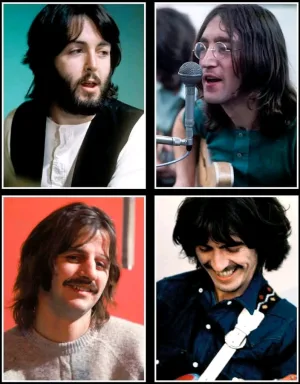Unveiling Let It Be’s Secrets: 5 Jaw-Dropping Facts About The Beatles’ Iconic Farewell Album Revealed!**
The Beatles’ *Let It Be* stands as one of the most compelling and controversial albums in rock history. Released in 1970, amid the band’s tumultuous breakup, it’s often viewed through a prism of conflicting emotions—bittersweet nostalgia, artistic frustration, and raw sincerity. Beneath its familiar melodies lies a treasure trove of stories and secrets that continue to fascinate fans and scholars alike. Here are five jaw-dropping facts that peel back the layers of this legendary record, revealing the turbulent, creative, and sometimes contentious process behind its creation.
1. **Billy Preston’s Game-Changing Contribution: The Fifth Beatle**
One of the most celebrated facts about *Let It Be* is the pivotal role played by Billy Preston. When the band was struggling with internal tensions and creative disagreements, Preston’s arrival in the studio in early 1969 brought a much-needed infusion of positivity and musical camaraderie. His keyboard skills and infectious enthusiasm earned him the nickname “the Fifth Beatle.” Preston’s presence was so significant that he was included in the album credits and even performed with the band on the rooftop concert, *Get Back*.
Preston’s influence extended beyond mere musicianship. His upbeat energy and diplomatic presence helped bridge the cracks within the band, facilitating a more collaborative atmosphere. Many fans and critics argue that Preston’s contributions—most notably on tracks like “I’ve Got a Feeling” and the iconic “Get Back” reprise—elevated *Let It Be* from a collection of rough sketches to a more cohesive and emotionally resonant album. His involvement underscores how an outsider’s fresh perspective can sometimes be the catalyst for artistic breakthrough.
2. **Paul McCartney’s 33-Year Grudge Against Phil Spector’s Mix**
A controversial chapter in the *Let It Be* saga revolves around the involvement of producer Phil Spector. After the original sessions in January 1969, the Beatles originally intended the album to be a raw, stripped-down document of their live sound. However, after their breakup, producer Giles Martin and engineer Sam Okell reworked the album, and Spector’s lush, orchestral overdubs were added without the band’s full approval.
Paul McCartney, in particular, was vehemently opposed to Spector’s “Wall of Sound” embellishments, especially on tracks like “The Long and Winding Road.” For decades, McCartney harbored resentment toward Spector’s heavy-handed approach, which he felt compromised the song’s emotional integrity. This tension culminated in a long-standing feud, with McCartney publicly criticizing the producer’s work and even calling for the removal of Spector’s overdubs in subsequent reissues. It wasn’t until the 2021 *Let It Be* box set that McCartney finally authorized the release of the original, unaltered recordings, effectively settling a 33-year-old grudge and providing fans with a glimpse of the band’s initial vision.
3. **Was *Let It Be* a Masterpiece or a Patchwork Swan Song?**
Decades after its release, *Let It Be* remains a subject of debate. Was it a carefully crafted masterpiece or a hastily assembled farewell? Critics and fans alike have argued both sides. On one hand, the album contains some of The Beatles’ most enduring songs—“Across the Universe,” “Let It Be,” “The Long and Winding Road,” and “Get Back” are etched into the fabric of popular culture. Its raw, unpolished sound captures the band’s live energy and emotional vulnerability.
On the other hand, the album’s reputation as a “patchwork” stems from the tumultuous recording process. Much of the material was recorded during tense sessions where band members were often at odds. The post-production overdubs, especially under Spector’s influence, further clouded the original recordings. Some fans see *Let It Be* as a reflection of the band’s internal struggles—an album that, despite its imperfections, embodies their raw honesty and artistic resilience. Its legacy is complex: a haunting, beautiful reflection of a band on the brink of dissolution, yet still capable of creating timeless music.
4. **The Iconic Rooftop Concert: The Beatles’ Last Live Performance**
Few moments in rock history are as iconic as The Beatles’ impromptu rooftop concert on January 30, 1969. Filmed and recorded as part of the *Let It Be* sessions, this spontaneous gig atop Apple Corps headquarters in London became their final public performance together. With no fans, minimal rehearsal, and a sense of rebellious spontaneity, the band played five songs, including “Get Back,” “Don’t Let Me Down,” and “I’ve Got a Feeling.”
This event epitomized both the band’s raw energy and their internal tensions. It was a moment of liberation, a last hurrah that captured the essence of their live prowess before their eventual breakup. The rooftop concert was also a testament to their resilience—despite internal disagreements and external pressures, they could still produce electrifying music. Today, the footage remains a symbol of their enduring legacy and a poignant reminder of their fleeting unity.
5. **The Enduring Legacy: Why *Let It Be* Continues to Fascinate**
Despite its controversial production history and mixed critical reception upon release, *Let It Be* has achieved a mythic status in rock history. Its raw emotion, imperfect beauty, and glimpse into the band’s final days continue to resonate with fans worldwide. The album’s themes of hope, perseverance, and acceptance—epitomized by the title track—offer a haunting reflection of a band torn apart yet still capable of creating music that endures beyond its turbulent origins.
The *Let It Be* story underscores the complex relationship between artistic perfection and emotional authenticity. It invites listeners to consider whether the album’s flaws are part of its charm—an honest, unvarnished look at a band wrestling with change, loss, and ultimately, their legacy. The album remains a testament to The Beatles’ unparalleled influence and their ability to turn chaos into timeless art.
Final Thoughts**
*Let It Be* is more than just a farewell album; it’s a window into the soul of The Beatles during their final chapter. From Billy Preston’s uplifting influence to McCartney’s long-standing grievances, every aspect of its creation adds layers of meaning and emotion. Whether seen as a masterpiece or a patchwork, its raw, haunting beauty continues to fascinate and inspire generations. It’s a reminder that sometimes, the most imperfect art can be the most profound—a fitting tribute to a band that redefined music forever.



